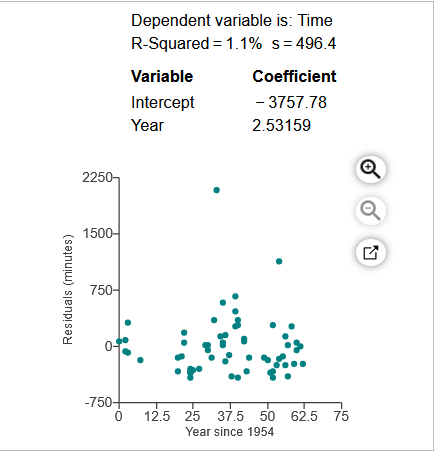Navigation » List of Schools, Subjects, and Courses » Math 2210 – Statistics » Quizzes » Quiz 3 (Chapters 6 , 7, and 8) Question 5
No Answers We dont have answer to this question yet. If you need help with your homework send us an email  or chat with our tutors
or chat with our tutors
Quiz 3 (Chapters 6 , 7, and 8) Question 5
Quiz 3
5. People swam across a certain lake 42 times between 1954 and 2016. We might be interested in whether they are getting any faster or slower. The accompanying display shows the regression of the crossing Times (minutes) against the Year since 1954 of the crossing and a plot of the residuals against Year since 1954. Complete parts a through c.

a) What does the R2 mean for this regression?
- The value of R2 means that the crossing times are growing by 98.9% each year.
- The value of R2 means that 98.9 % of the variation in crossing times is accounted for by this model.
- The value of R2 means that the variation in crossing times is growing by 1.1 % each year.
- The value of R2 means that 1.1 % of the variation in crossing times is accounted for by this model.
b) Are the swimmers getting faster or slower? Explain.
- Since the slope is positive, it appears that the swimmers are getting faster.
- Since the outlier condition is violated, there is a relatively large P-value of the coefficient and the slope should not be interpreted.
- Since the slope is negative, it appears that the swimmers are getting slower.
- Since the slope is negative, it appears that the swimmers are getting faster.
- Since the slope is positive, it appears that the swimmers are getting slower.
c) The outlier seen in the residuals plot is a crossing by a woman in 1987 in which she swam a round trip, north to south, and then back again. Clearly this swim doesn’t belong with the others. Would removing it change the model a lot? Explain.
- Since the point has high leverage, the slope will probably decrease significantly. The correlation will increase because the scatter about the regression line will decrease. The point should be removed, and this would probably change the model a lot.
- Since the point has low leverage, the slope will probably remain about the same. The correlation will increase because the scatter about the regression line will decrease. The point should be removed, and this would probably not change the model a lot.
- Since the point has high leverage, the slope will probably remain about the same. The correlation will decrease because the scatter about the regression line will decrease. The point should be removed, and this would probably not change the model a lot.
- Since the point has low leverage, the slope will probably decrease significantly. The correlation will increase because the scatter about the regression line will decrease. The point should be removed, and this would probably change the model a lot.
 or chat with our tutors
or chat with our tutors
